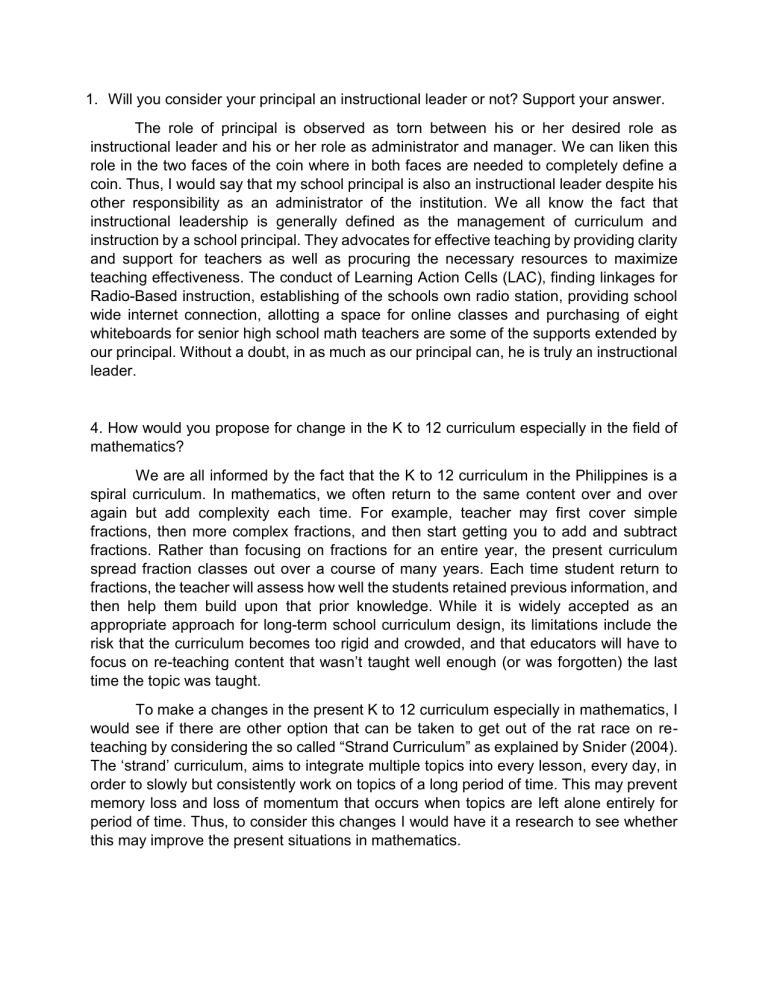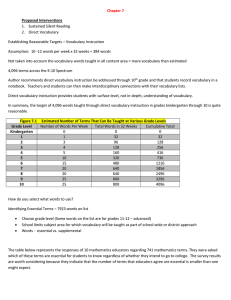
1. Will you consider your principal an instructional leader or not? Support your answer. The role of principal is observed as torn between his or her desired role as instructional leader and his or her role as administrator and manager. We can liken this role in the two faces of the coin where in both faces are needed to completely define a coin. Thus, I would say that my school principal is also an instructional leader despite his other responsibility as an administrator of the institution. We all know the fact that instructional leadership is generally defined as the management of curriculum and instruction by a school principal. They advocates for effective teaching by providing clarity and support for teachers as well as procuring the necessary resources to maximize teaching effectiveness. The conduct of Learning Action Cells (LAC), finding linkages for Radio-Based instruction, establishing of the schools own radio station, providing school wide internet connection, allotting a space for online classes and purchasing of eight whiteboards for senior high school math teachers are some of the supports extended by our principal. Without a doubt, in as much as our principal can, he is truly an instructional leader. 4. How would you propose for change in the K to 12 curriculum especially in the field of mathematics? We are all informed by the fact that the K to 12 curriculum in the Philippines is a spiral curriculum. In mathematics, we often return to the same content over and over again but add complexity each time. For example, teacher may first cover simple fractions, then more complex fractions, and then start getting you to add and subtract fractions. Rather than focusing on fractions for an entire year, the present curriculum spread fraction classes out over a course of many years. Each time student return to fractions, the teacher will assess how well the students retained previous information, and then help them build upon that prior knowledge. While it is widely accepted as an appropriate approach for long-term school curriculum design, its limitations include the risk that the curriculum becomes too rigid and crowded, and that educators will have to focus on re-teaching content that wasn’t taught well enough (or was forgotten) the last time the topic was taught. To make a changes in the present K to 12 curriculum especially in mathematics, I would see if there are other option that can be taken to get out of the rat race on reteaching by considering the so called “Strand Curriculum” as explained by Snider (2004). The ‘strand’ curriculum, aims to integrate multiple topics into every lesson, every day, in order to slowly but consistently work on topics of a long period of time. This may prevent memory loss and loss of momentum that occurs when topics are left alone entirely for period of time. Thus, to consider this changes I would have it a research to see whether this may improve the present situations in mathematics. Advantages and disadvantages of spiral curriculum. Advantages Developmentally Appropriate Learning: Often times, we will challenge a student to the furthest extent of their current abilities. Once we’ve gone as far as we can go, we might have to wait a few months or even a year until their mind has developed some more and they are more capable of grappling with the topic. When you return to the topic, the student may be at a developmentally appropriate level to understand the topic even more. This advantage relies on the cognitive constructivist premise that brains develop as we age, often in distinct stages. Prior Knowledge is Central to Learning: This approach necessarily employs the notion of ‘prior knowledge’. This concept acknowledges that students enter a classroom with a history of learning and knowing that can be employed in classroom practice. By assessing prior knowledge and using it in the classroom, we can move toward a student-centered teaching style. Spaced Repetition Occurs: Spaced repetition is a concept from the behaviorist theory of learning. It explains how committing knowledge to memory occurs best when you space out practice of a task over time. Each time you re-engage with the concept, you have to recall it from your memory. Like exercising a muscle, the more you exercise that little packet of memory, the stronger it gets and the less likely you will be to forget it. Teachers Focus on structuring work to follow Logical Progression: When developing this type of curriculum, educators and curriculum designers need to pause and reflect on what ‘prior knowledge’ is required in order to learn something. This explicit reflection on progression of understanding puts continual growth at the center of the student’s learning experience. Integration and Collaboration: Educators collaborate to ensure a holistic and coherent learning sequence is provided over time. Disadvantages Time Consuming for Designers: Curriculum designers need to collaborate and coordinate for this model to work. Designers and educators need to come together over several meetings to agree on what will be taught, when, and by whom, so that the whole curriculum is cohesive and does not miss anything or contain redundancies. Curriculum Crowding: If educators have a lot to teach, and then re-teach, the curriculum can get too crowded. Educators might lightly touch on a concept then move on from it with the belief that “we will return to it”. A better alternative may be mastery teaching, where a student does not move on until they have mastered the topic. Irrelevant for Short Courses: Short courses can return to the content in single lessons, but long-term reinforcement is impossible if a course is only taught over a short period of time. Risk of becoming Teacher Centered: When the curriculum is designed in a longitudinal fashion with a long horizon, the teachers make guesses about a student’s competency level at certain times into the future. A flexible curriculum needs to be differentiated to a student’s learning stages and speeds, which may be unachievable if the curriculum is designed too far in advance. Gap Filling: Often, a teacher will find that instead of building on prior knowledge, they are re-teaching information that was forgotten, taught poorly previously, the facts have changed, or entails many misconceptions. “NO CHILD LEFT BEHIND” “All, regardless of race or class or economic status, are entitled to a fair chance and to the tools for developing their individual powers of mind and spirit to the utmost. This promise means that all children by virtue of their own efforts, competently guided, can hope to attain the mature and informed judgement needed to secure gainful employment, and to manage their own lives, thereby serving not only their own interests but also the progress of society itself.” – A Nation at Risk, 1983

